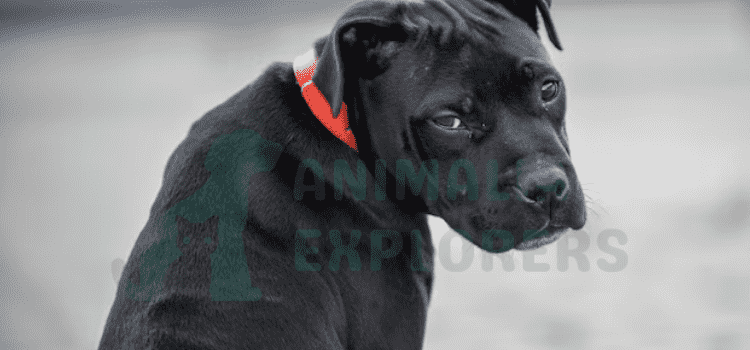“Barking and Anxiety: Are bark collars right for your anxious pup?

Are bark collars right for your anxious pup?
Do you have a furry friend who is prone to barking when left alone? While it may be normal behavior for some dogs, it can become problematic if the barking becomes excessive or persistent. If your pup has developed separation anxiety, a bark control collar might be just what they need to keep their barking in check. In this blog post, we’ll take an in-depth look at whether a bark collar works for separation anxiety – examining how these collars help treat this issue and the different types of bark control that are available for purchase. Read on to gain valuable insight into determining whether a Bark Control Device is the right solution for your four-legged friend!
Overview of Separation Anxiety in Dogs
Dogs are known for being loyal and affectionate companions, but they can also experience separation anxiety when they’re separated from their owners. This can cause a lot of stress and behavioral problems for both the dog and their owner. While some people turn to shock collars as a way to train their dogs out of separation anxiety, it’s important to note that this method can make the problem worse. Instead, it’s important to address the root causes of separation anxiety and work with your dog to build confidence and independence. With patience and understanding, you can help your furry friend feel more comfortable being on their own for short periods.
How Bark Collars Help with Separation Anxiety

So, what exactly is a bark collar and how can it help with separation anxiety? A bark collar is a device that emits a corrective stimulus, such as vibration or sound, when your dog barks. This serves as negative reinforcement, teaching your dog that excessive barking is unacceptable behavior. The use of bark collars for separation anxiety is controversial, as some argue that it may cause further stress and fear in dogs. However, when used correctly and in conjunction with positive reinforcement training techniques, bark collars can be an effective tool in managing barking behavior.
Types of Bark Collars
There are several types of bark collars, each designed to deter excessive barking using different methods:
- Static Shock Bark Collars: When triggered, these collars deliver a small static shock to the dog, discouraging them from barking. The intensity of the shock can often be adjusted to suit the size and temperament of the dog.
- Vibration Bark Collars: These collars vibrate when they detect barking. The unexpected sensation distracts and deters the dog from continuing to bark.
- Ultrasonic Bark Collars: When activated, these collars emit a high-pitched sound that is unpleasant for dogs but virtually inaudible to humans. The sound serves as a deterrent to stop the dog from barking.
- Spray Bark Collars: These collars release a burst of citronella or water spray in front of the dog’s face when they bark, interrupting and deterring the behavior.
- Dual Sensor Bark Collars: These collars are equipped with both vibration and sound sensors to ensure that the collar is only activated by the dog’s barking, reducing the chance of false activations.
Symptoms of Separation Anxiety
Separation anxiety is a serious condition affecting many dogs. Symptoms may include whining, howling, destructive behavior, and even self-harm. As a dog owner, it’s important to be aware of these signs and take steps to address them. While some pet owners have turned to shock collars as a solution, it’s important to note that these collars can exacerbate anxiety and lead to more aggressive behavior. Instead, consider steps like gradually increasing the amount of time your dog spends alone, leaving comforting items like a favorite blanket or toy in their space, and seeking guidance from a professional trainer or veterinarian. With patience and care, separation anxiety can be managed and your furry friend can find peace when left alone.
Symptoms of Separation Anxiety in Dogs

Dogs suffering from separation anxiety may exhibit a variety of symptoms. Pet owners must be able to recognize these signs so that they can take appropriate action. Here are the common symptoms associated with separation anxiety in dogs:
- Excessive Barking or Howling: If your dog barks or howls excessively when left alone, this may be a sign of separation anxiety.
- Destructive Behavior: Dogs may resort to destructive behaviors such as chewing furniture, digging at doors, or scratching at windows when suffering from separation anxiety.
- Urination and Defecation: Despite being house-trained, a dog with separation anxiety might urinate or defecate inside the house when left alone.
- Pacing: Some dogs might walk or trot along a specific path in a fixed pattern when left alone.
- Escape Attempts: Dogs with separation anxiety may try to escape from where they are confined when left alone. This could lead to self-injury.
- Changes in Appetite: Dogs might lose their appetite and refuse to eat, especially when their owner isn’t present.
- Salivation: Excessive salivation is another common symptom of separation anxiety in dogs.
- Depression or Anxiety: Just like humans, dogs can also show signs of depression or anxiety, such as excessive licking or chewing on themselves, loss of interest in their favorite toys, or a lack of energy.
Remember, these symptoms can also be indicative of other issues, so it’s important to consult with a vet or a professional dog behaviorist if your pet displays any of these signs to get a proper diagnosis and treatment plan.
Causes of Separation Anxiety
Dogs are social creatures that thrive on companionship and routine. Therefore, when separation anxiety builds up in dogs, it can be an upsetting experience for both the owner and the pet. Separation anxiety can manifest in destructive behaviors such as chewing, scratching, or excessive barking, and can be caused by factors like abandonment, change in routine, or anxiety triggers. Using tools like a dog collar or a bark collar can help alleviate the symptoms of separation anxiety and promote comfort when left alone at home. However, it is essential to identify the root cause of the anxiety and work towards resolving it for a happier, more relaxed furry friend.
Separation anxiety in dogs can be triggered by several factors. Here are some common causes:
- Change in Environment: A sudden move or change in living situations can trigger separation anxiety in dogs. They may feel uneasy or scared in a new environment, particularly if their owner is not around.
- Change in Family: The addition or loss of a family member can be stressful for dogs and can lead to separation anxiety. This could be the arrival of a new baby, the death of a family member, or even when a family member moves out.
- Change in Schedule: Dogs thrive on routine. An abrupt change in their daily schedule – such as their feeding, walking, or playtime – can cause distress and lead to separation anxiety.
- History of Abandonment or Neglect: Dogs who have been abandoned or neglected in the past are more likely to suffer from separation anxiety. They may fear being left alone and react accordingly when their owner is away.
- Traumatic Events: Dogs can develop separation anxiety after experiencing a traumatic event such as a natural disaster, accident, or injury. The fear and stress from the event can translate into anxiety when they are left alone.
- Aging or Health Issues: As dogs age, they may develop health issues that could lead to separation anxiety. Cognitive dysfunction syndrome (CDS) is one such condition that affects older dogs and can cause behavioral changes including separation anxiety.
Understanding these triggers can help dog owners take preventative measures and implement strategies to help manage their pet’s separation anxiety. The goal is to help dogs feel safe and secure, even when they are alone.
Treatments for Separation Anxiety

Separation anxiety can hurt your furry friend and leave them feeling stressed and insecure when left alone. Luckily, there are several treatments available that can help alleviate their anxiety. One option is to use a dog collar that is specially designed to combat separation anxiety. These collars can emit calming pheromones or vibrations that may soothe your pet in your absence. However, some pet owners may resort to using a shock collar to control separation anxiety. Though it may appear to be a quick solution, it’s important to note that shock collars can have harmful physical and psychological effects on your pet and are generally not recommended by animal behaviorists. It’s crucial to seek advice from a professional to determine the best course of treatment for your furry friend’s specific needs. Other treatment options may include:
- Behavioral Training: Working with a professional dog trainer or behaviorist can help address your pet’s separation anxiety. They can provide you with techniques and exercises to gradually help your dog feel more comfortable when left alone.
- Desensitization Therapy: This therapy involves exposing your pet to short periods of being left alone and gradually increasing the duration over time. This can help build your dog’s tolerance and confidence when it comes to being alone.
- Medication: In severe cases, a veterinarian may prescribe medication to help calm and relax your pet during times of separation.
- Companionship: If possible, having another pet or even a human companion can alleviate separation anxiety in dogs. A trusted friend or family member can come over and keep your pooch company while you’re away.
Remember, every dog is unique, and what works for one may not work for another. It’s essential to work closely with a professional to determine the best treatment plan for your pet’s separation anxiety.
How to Ease Separation Anxiety in Dogs
Leaving home can be emotionally challenging for dog owners, especially if their pet experiences separation anxiety. Dogs often become disruptive when left alone, which can include whining, barking, and other unwanted behaviors. To help alleviate their anxiety, it is important to address their behavior by providing positive reinforcement, mental and physical stimulation, and tools like bark collars. Bark collars can emit a sound or vibration when a dog barks excessively, which can help discourage this behavior and promote a calmer, more relaxed pet. Consistency and predictability in your dog’s routine can also help them feel more secure and reduce the likelihood of anxiety triggers. It’s important to provide your dog with plenty of mental and physical stimulation, such as interactive toys or puzzles, regular walks, and playtime with other dogs. These activities can keep their minds occupied and prevent boredom while you’re away. By taking the time to understand your dog’s needs and providing them with the care and support they require, you can help them overcome separation anxiety and live a happier, more relaxed life. Always pay attention to any changes in behavior or signs of anxiety in your pet, and take steps to address them early on. Remember, your dog depends on you for their well-being and happiness, so it’s crucial to provide them with the support and care they need to thrive in any environment.
By understanding the triggers and utilizing effective treatment methods, separation anxiety can be managed in dogs. However, prevention is always better than cure.
Understanding Bark Collars
Bark collars are a topic that can divide pet owners, but they can be useful in certain circumstances. These kinds of collars can deliver a mild shock or citronella spray when a dog barks, which can act as a deterrent. However, it’s essential to note that bark collars may not always work for separation anxiety. While excessive barking can be a symptom of separation anxiety, it’s rarely the root cause of this behavior. If you suspect your dog is struggling with separation anxiety, consider speaking with a veterinarian or dog behavior specialist to determine the best course of action.
In addition to treatment options, there are also ways to prevent separation anxiety from developing in the first place. Early socialization and training can help your dog learn how to feel confident and secure when alone. Introducing them to different environments and people at an early age can help build their resilience and adaptability. Additionally, practicing leaving them alone for short periods starting from a young age can help them get used to the experience and prevent separation anxiety from developing later on. It’s important to remember that every dog is different, and it may take some trial and error to find the best approach for your furry friend. But with patience, love, and proper care, you can help your dog overcome their separation anxiety and live a happy, healthy life. So keep an eye out for any signs of distress or anxiety in your pet and take the necessary steps to help them feel more comfortable and confident when left alone. Your dog will thank you for it. So don’t hesitate to seek professional guidance and support when needed, as it can make a significant difference in your dog’s well-being. Remember, a happy and relaxed dog makes for a happy and relaxed owner, so investing in your pet’s mental health is essential for both of you. So continue to educate yourself on separation anxiety in dogs and stay proactive in managing it, and you’ll have a happier and healthier relationship with your furry companion. Let’s give our dogs the love and care they deserve!
Pros and Cons of Bark Collars for Treating Separation Anxiety

As pet owners, we love our furry friends but sometimes they develop separation anxiety which can make leaving them behind a difficult experience. Bark collars are an option to treat this condition but they do come with pros and cons. On the positive side, they can prevent excessive barking and thus complaints from neighbors. However, it’s important to consider the type of collar being used as some may inflict pain or even cause harm. While eliminating excessive barking, the collar may also hinder some dogs from communicating in a natural way, which could cause undue stress. Ultimately, it’s important to weigh the pros and cons of using a bark collar with your veterinarian to determine if it’s the best option for your pet’s needs.
Pros of Using Bark Collars for Treating Separation Anxiety:
- Prevents excessive barking: Bark collars can deter dogs from barking excessively when they’re alone, which may provide some relief from symptoms of separation anxiety.
- Avoids neighbor complaints: Bark collars can help prevent noise complaints from neighbors who might be disturbed by your dog’s continual barking.
- Provides immediate feedback: The feedback from a bark collar is immediate, which can help reinforce the idea that excessive barking is undesirable behavior.
Cons of Using Bark Collars for Treating Separation Anxiety:
- May not address the root cause: While bark collars might deter excessive barking, they do not address the root cause of separation anxiety, which could mean the problem persists despite reduced barking.
- Potential for undue stress or harm: Some types of bark collars can inflict pain or stress on your pet, which may end up exacerbating anxiety rather than relieving it.
- Hinders natural communication: Dogs use barking to communicate. Using a bark collar might prevent your dog from naturally expressing themselves, leading to potential stress or confusion.
- Can be seen as a ‘quick fix’: A bark collar may seem like an easy solution, but it may not be effective in the long term, especially if other elements of your dog’s life or environment are contributing to their anxiety.
- Possibility of false triggers: Depending on the sensitivity of the collar, it can sometimes be triggered by noises other than barking, which can cause confusion or unnecessary stress for your dog.
Tips for Choosing the Right Bark Collar for Your Dog

If your furry friend has an excessive barking problem, a bark collar might be the perfect solution for you. But with so many different types of bark collars available, it can be overwhelming to choose the right one for your dog. The first step is to consider your dog’s size, breed, and temperament. Some bark collars are only suitable for smaller dogs, while others are designed for larger breeds. You also want to consider the type of bark collar – some use a spray, vibration, or shock, while others have a combination of these features. The most important thing is to choose a bark collar that is safe and humane for your dog while effectively reducing their barking. So take your time and carefully evaluate the options before making a decision.
Tips for Choosing the Right Bark Collar:
- Consider your dog’s size and breed: Bark collars come in various sizes and are designed to fit specific breeds. Be sure to choose a collar that’s appropriate for your dog’s size and breed.
- Evaluate your dog’s temperament: Different dogs have different temperaments. Some dogs might respond better to certain types of stimuli than others. Understanding your dog’s temperament can help you choose the most effective collar.
- Choose the right type of stimulus: Bark collars use different types of stimuli such as spray, vibration, or shock. Some dogs might respond better to one type of stimulus than another. Choose the one that suits your dog best.
- Opt for adjustable sensitivity: Choose a collar with adjustable sensitivity. This allows you to set the collar to respond to your dog’s specific bark and not other noises that could trigger the collar unnecessarily.
- Consider the collar’s safety features: Make sure the collar has safety features like automatic shut-off after a certain period of continuous activation to prevent over-correction and potential distress.
- Look for durable and waterproof features: The collar should be durable and waterproof, especially if your dog enjoys outdoor activities.
- Consult with a professional: If unsure, consult with a veterinarian or a professional dog trainer. They can provide valuable insight into the type of bark collar that would be most suitable for your dog.
Alternatives to Bark Collars for Treating Separation Anxiety

Dealing with separation anxiety in dogs can be challenging. While bark collars may seem like a quick solution, many pet owners prefer alternative and more humane methods. Some of the most effective alternatives include counterconditioning, crate training, and anti-anxiety medications. Counterconditioning involves desensitizing the dog to their fear by gradually introducing them to the trigger in a positive and controlled environment. Crate training helps to provide a safe and secure space for the dog while they are alone. Anti-anxiety medications, prescribed by a veterinarian, can also help to reduce anxiety and fear in dogs. These alternatives may take longer to take effect, but they offer a more compassionate and long-term solution for treating separation anxiety in dogs.
How to Monitor Your Dog’s Reaction to a Bark Collar
A bark collar can be an effective solution for dogs who tend to bark excessively. However, it is important to monitor your dog’s reaction to the collar to ensure that it is not causing any undue stress or discomfort. Some signs that your dog may be unhappy with the collar include scratching or biting at it, excessively vocalizing, or exhibiting unusual behavior such as hiding or pacing. If you notice any of these indicators, it may be necessary to adjust the collar or seek alternative solutions to curb your dog’s barking. Remember, the ultimate goal is to find a safe and humane solution that provides peace for both you and your furry companion. So, continue to monitor your dog’s behavior and adjust accordingly until you find the right solution for your specific situation. Additionally, it is always recommended to consult with a professional if you have any concerns about using a bark collar on your dog. They can provide personalized advice and guidance to ensure the well-being and happiness of your pet. Overall, while bark collars may offer a quick solution, it is important to carefully consider your options and choose the most suitable and humane method for your dog’s well-being. By understanding your dog’s needs and behavior, you can make an informed decision that will not only reduce excessive barking but also promote a healthy and happy relationship between you and your furry friend.
FAQs
Can a bark collar hurt my dog?
When used correctly, bark collars are designed to be safe and not inflict physical harm. However, they can cause discomfort, and in some cases, stress or anxiety. Always ensure you choose a humane option and monitor your dog’s reaction to the collar.
How quickly will a bark collar correct my dog’s excessive barking?
The effectiveness of a bark collar can vary from dog to dog. Some dogs might respond immediately, while others may take several days or weeks. Consistency is key, and it’s important to combine the use of the collar with comprehensive training methods.
Is it possible for my dog to get used to the bark collar and start ignoring it?
Some dogs may become accustomed to the stimulus over time, which may result in the collar becoming less effective. If this happens, you may want to consider alternating between different forms of stimuli or seek advice from a professional.
Can I use a bark collar on a puppy?
Most experts advise against using a bark collar on puppies, especially those under six months of age. Young dogs are still learning and developing, and it’s usually best to try other training methods first. Always consult with a veterinarian or a professional trainer to discuss the best options for your puppy.
How long can my dog wear a bark collar?
It’s recommended that a dog should not wear a bark collar for more than 12 hours at a time. This helps to prevent pressure sores and discomfort. Always remove the collar at night or during times when the dog’s barking should be acceptable.
Conclusion
As we come to the end of our discussion on bark collars, it is important to keep in mind that every dog is unique, and what may work for one dog, may not work for another. While some people may vouch for the effectiveness of bark collars, others may perceive them as unnecessary or even cruel. It is crucial to research and assess various options before selecting a bark collar and to always use them responsibly and according to the instructions provided. Ultimately, the objective is to find a solution that helps you and your furry friend coexist in harmony while ensuring their safety and well-being. Therefore, whether you choose to use a bark collar or explore alternative methods, always prioritize the comfort and happiness of your dog above everything else. We appreciate you reading our guide on selecting the appropriate bark collar for your dog and hope that it has offered useful information and guidance to help you make an informed decision for your beloved pet.






